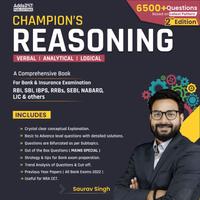Directions (1-5): The question given below is followed by two statements numbered I and II. You have to decide whether the data provided in the statements sufficient to answer the question:
Q1. Seven persons T, L, M, D, K, W and H are sitting in a row facing north but not necessarily in the same order. Which of the following persons sit fourth to the left of M?
I. M sits second to the right of T. Two persons sit between T and W. K sits second to the left of W. Only one person sits between H and L. D sits second left of K.
II. Three persons sit between H and K. Either H or K sits at one of the extreme end. T sits left of W. L and T are immediate neighbours. M sits right of K.
(a) If the data in the statement I alone is sufficient to answer the question, while the data in statement II alone is not sufficient to answer the question.
(b) If the data in the statement II alone is sufficient to answer the question, while the data in statement I alone is not sufficient to answer the question.
(c) If the data either in the statement I alone or in statement II alone is sufficient to answer the question.
(d) If the data in both the statement I and II together are not sufficient to answer the question.
(e) If the data in both the statement I and II together are necessary to answer the question.
Q2. Certain number of persons are sitting in a row facing north. Who among the following sits immediate right of C?
I. Only three persons sit between A and D who sits one of the ends. B sits third to the right of C who is not an immediate neighbour of F.
II. C sits fourth to the right of H. E sits second to the left of B who sits one of the extreme ends. F neither immediate neighbour of H nor E.
(a) If the data in the statement I alone is sufficient to answer the question, while the data in statement II alone is not sufficient to answer the question.
(b) If the data in the statement II alone is sufficient to answer the question, while the data in statement I alone is not sufficient to answer the question.
(c) If the data either in the statement I alone or in statement II alone is sufficient to answer the question.
(d) If the data in both the statement I and II together are not sufficient to answer the question.
(e) If the data in both the statement I and II together are necessary to answer the question.
Q3. Who among L, Q, C, T, and U is the oldest?
I. C and T are older than L and U.
II. Q is older than L but younger than C.
(a) If the data in the statement I alone is sufficient to answer the question, while the data in statement II alone is not sufficient to answer the question.
(b) If the data in the statement II alone is sufficient to answer the question, while the data in statement I alone is not sufficient to answer the question.
(c) If the data either in the statement I alone or in statement II alone is sufficient to answer the question.
(d) If the data in both the statement I and II together are not sufficient to answer the question.
(e) If the data in both the statement I and II together are necessary to answer the question.
Q4. What is the code for ‘women’ in the code language?
I. In the code language ‘she women fast’ is written as ‘he ka to’.
II. In the code language ‘she learns fast’ is written as ‘jo ka he’.
(a) If the data in the statement I alone is sufficient to answer the question, while the data in statement II alone is not sufficient to answer the question.
(b) If the data in the statement II alone is sufficient to answer the question, while the data in statement I alone is not sufficient to answer the question.
(c) If the data either in the statement I alone or in statement II alone is sufficient to answer the question.
(d) If the data in both the statement I and II together are not sufficient to answer the question.
(e) If the data in both the statement I and II together are necessary to answer the question.
Q5. Seven persons H, L, K, B, S, W and D were born in different months March, May, June, August, September, October and November but not necessarily in the same order. Who was born in June?
I. Three persons were born between B and H. H was born after B. S was born immediately before D but not immediately after B.
II. As many persons born before K were born after H. W was born after L. D was born in the month which has odd number of days.
(a) If the data in the statement I alone is sufficient to answer the question, while the data in statement II alone is not sufficient to answer the question.
(b) If the data in the statement II alone is sufficient to answer the question, while the data in statement I alone is not sufficient to answer the question.
(c) If the data either in the statement I alone or in statement II alone is sufficient to answer the question.
(d) If the data in both the statement I and II together are not sufficient to answer the question.
(e) If the data in both the statement I and II together are necessary to answer the question.
Solutions

Hence, the data in the statement I alone is sufficient to answer the question, while the data in statement II alone is not sufficient to answer the question.
S2. Ans. (e)
Sol. By combining both the statement we can find E sits immediate right of C.
S3. Ans. (d)
Sol. From Statement I: C, T > L, U; we can’t decide the oldest.
From Statement II: C > Q > L; We can’t decide the oldest.
Combining Statements, I and II: As, there is no relation between T and C we can’t decide who is oldest.
S4. Ans. (e)
Sol. Combining Statements I and II: we can eliminate ‘she’ and ‘fast’ then women is coded as “to”. Hence data in both the Statements I and II together is necessary to answer the question.

 . . . .
. . . .




 GA Capsule for SBI Clerk Mains 2025, Dow...
GA Capsule for SBI Clerk Mains 2025, Dow...
 The Hindu Review October 2022: Download ...
The Hindu Review October 2022: Download ...
 Hindu Review March 2025, Download Monthl...
Hindu Review March 2025, Download Monthl...





